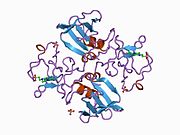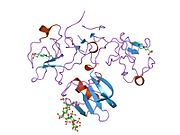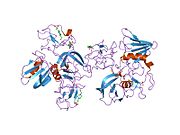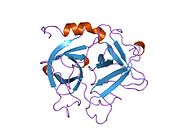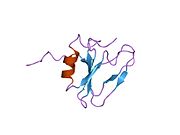Hepatocyte growth factor
Ensembl | |||||||||
|---|---|---|---|---|---|---|---|---|---|
| UniProt | |||||||||
| RefSeq (mRNA) | |||||||||
| RefSeq (protein) | |||||||||
| Location (UCSC) | Chr 7: 81.7 – 81.77 Mb | Chr 5: 16.76 – 16.83 Mb | |||||||
| PubMed search | [3] | [4] | |||||||
| View/Edit Human | View/Edit Mouse |
Hepatocyte growth factor (HGF) or scatter factor (SF) is a
Function
Hepatocyte growth factor regulates cell growth, cell motility, and
Structure
It is secreted as a single inactive polypeptide and is cleaved by serine proteases into a 69-kDa alpha-chain and 34-kDa beta-chain. A disulfide bond between the alpha and beta chains produces the active, heterodimeric molecule. The protein belongs to the
Clinical significance
Excessive local expression of HGF in the
HGF has been implicated in a variety of cancers, including of the lungs, pancreas, thyroid, colon, and breast.[18][19][20]
Increased expression of HGF has been associated with the enhanced and scarless wound healing capabilities of fibroblast cells isolated from the oral mucosa tissue.[21]
Circulating plasma levels
Plasma from patients with advanced heart failure presents increased levels of HGF, which correlates with a negative prognosis and a high risk of mortality.[22][23] Circulating HGF has been also identified as a prognostic marker of severity in patients with hypertension.[24] Circulating HGF has been also suggested as a precocious biomarker for the acute phase of bowel inflammation.[25]
Pharmacokinetics
Modulators
Interactions
Hepatocyte growth factor has been shown to
See also
- Epidermal growth factor
- Insulin-like growth factor 1
- Epithelial–mesenchymal transition
- Madin-Darby Canine Kidney Cells
References
- ^ a b c GRCh38: Ensembl release 89: ENSG00000019991 – Ensembl, May 2017
- ^ a b c GRCm38: Ensembl release 89: ENSMUSG00000028864 – Ensembl, May 2017
- ^ "Human PubMed Reference:". National Center for Biotechnology Information, U.S. National Library of Medicine.
- ^ "Mouse PubMed Reference:". National Center for Biotechnology Information, U.S. National Library of Medicine.
- ^ Gallagher, J.T., Lyon, M. (2000). "Molecular structure of Heparan Sulfate and interactions with growth factors and morphogens". In Iozzo, M, V. (ed.). Proteoglycans: structure, biology and molecular interactions. Marcel Dekker Inc. New York, New York. pp. 27–59.
{{cite book}}: CS1 maint: multiple names: authors list (link) - ^ PMID 1846706.
- PMID 8514254.
- PMID 35909816.
- ^ a b "Entrez Gene: HGF hepatocyte growth factor (hepapoietin A; scatter factor)".
- S2CID 23419866.
- S2CID 26812780.
- PMID 26070483.
- PMID 27434585.
- PMID 21288813.
- PMID 24720804.
- PMID 7555716.
- S2CID 9310133.
- ISBN 978-1-4612-1876-0.
- S2CID 3089594.
- PMID 21934211.
- PMID 28837064.
- PMID 23218577.
- S2CID 22426278.
- S2CID 6615179.
- PMID 25174881.
- PMID 11283849.
- PMID 8450646.
- S2CID 20021569.
- PMID 17519892.
- PMID 25187433.
- PMID 25649658.
- S2CID 41360989.
- PMID 8380735.
- PMID 1655405.
- PMID 7553606.
- PMID 8930021.
- ^ S2CID 29982976.
- S2CID 39689713.
- S2CID 25507615.
Further reading
- Michalopoulos GK, Zarnegar R (1992). "Hepatocyte Growth Factor". Hepatology. 15 (1): 149–54. S2CID 39873193.
- Nakamura T (1992). "Structure and function of hepatocyte growth factor". Progress in Growth Factor Research. 3 (1): 67–85. PMID 1838014.
- Ware LB, Matthay MA (May 2002). "Keratinocyte and hepatocyte growth factors in the lung: roles in lung development, inflammation, and repair". American Journal of Physiology. Lung Cellular and Molecular Physiology. 282 (5): L924-40. S2CID 22175256.
- Funakoshi H, Nakamura T (January 2003). "Hepatocyte growth factor: from diagnosis to clinical applications". Clinica Chimica Acta; International Journal of Clinical Chemistry. 327 (1–2): 1–23. PMID 12482615.
- Skibinski G (2004). "The role of hepatocyte growth factor/c-met interactions in the immune system". Archivum Immunologiae et Therapiae Experimentalis. 51 (5): 277–82. PMID 14626426.
- Kalluri R, Neilson EG (December 2003). "Epithelial-mesenchymal transition and its implications for fibrosis". The Journal of Clinical Investigation. 112 (12): 1776–84. PMID 14679171.
- Hurle RA, Davies G, Parr C, Mason MD, Jenkins SA, Kynaston HG, Jiang WG (October 2005). "Hepatocyte growth factor/scatter factor and prostate cancer: a review". Histology and Histopathology. 20 (4): 1339–49. PMID 16136515.
- Kemp LE, Mulloy B, Gherardi E (June 2006). "Signalling by HGF/SF and Met: the role of heparan sulphate co-receptors". Biochemical Society Transactions. 34 (Pt 3): 414–7. S2CID 31340761.
- Ejaz A, Epperly MW, Hou W, Greenberger JS, Rubin PJ (March 2019). "Adipose-derived stem cell therapy ameliorates ionizing irradiation fibrosis (RIF) via hepatocyte growth factor mediated TGF-β down regulation and recruitment of bone marrow cells". Stem Cells. 37 (6): 791–802. PMID 30861238.
External links
- Hepatocyte+growth+factor at the U.S. National Library of Medicine Medical Subject Headings (MeSH)
- Hepatocyte growth factor on the Atlas of Genetics and Oncology
- UCSD Signaling Gateway Molecule Page on HGF
- Overview of all the structural information available in the PDB for UniProt: P14210 (Hepatocyte growth factor) at the PDBe-KB.

